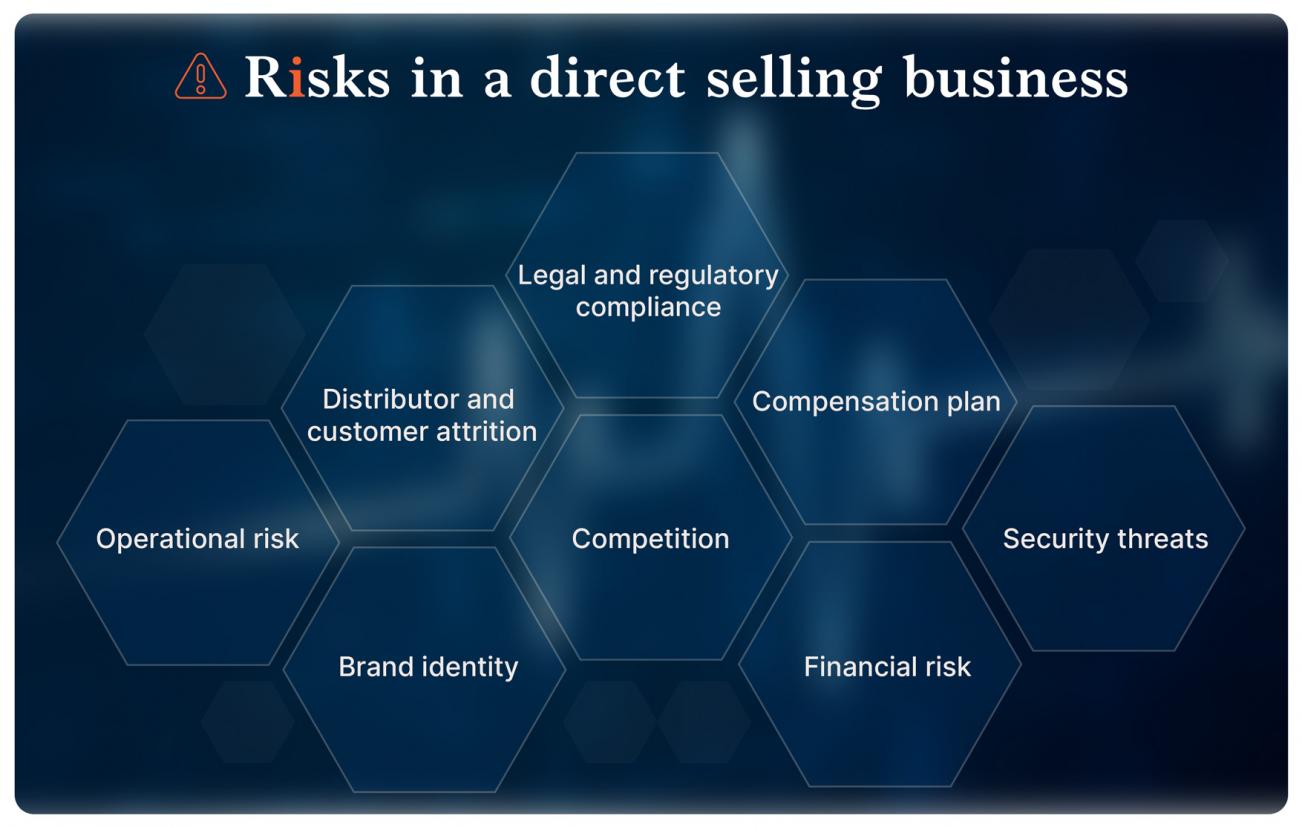Risk is staying out of your comfort zone and diving into the unknown.
Especially in businesses, taking risks is the first step to success. Being averse to risks can deprive you of the golden opportunities to succeed. Just think about how we got to the moon, how we fly among the clouds, and how we conquered the world!
The risk factor was, is, and will always be there in everything we do. Confidently overcoming it is where the intelligence to succeed lies.
What is risk management in business?
“Risky business” is the most commonly used and exploited term. It implies that growing and managing a business is full of risks and how well you manage it determines your ability to succeed.

In the purely technical sense of it, risk management is the process of identifying, assessing, controlling, and eliminating threats that could otherwise be fatal to the sustenance of the business. Rather than focusing on the positives of the business, risk management focuses on the negative aspects of the business such as threats and failures.
Risks in a direct selling business
Just as any business, probably more, direct sales businesses face risks of various forms and sizes. A diverse and widespread workforce adds to the intensity of the risks.

Epixel has been working on innovative solutions for enhancing the performance of direct selling businesses. We understand how inherent risks can adversely affect the growth of businesses. Here, we identify the diverse risks direct selling businesses encounter every day. We have also curated risk management strategies to help direct selling companies overcome these risks skillfully.
Legal and regulatory compliance
Legal and regulatory risk is the common and the most susceptible risk direct sales businesses encounter. Many popular direct selling companies have been penalized in the past for breaking the barriers of legal and regulatory compliance. The increased scrutiny is mostly attributed to distributor actions that are deemed illegal or non-compliant. It causes a serious breach of brand trust and identity.
PwC's Pulse Survey highlights that, according to 35% of risk executives, the greatest threat to an organization is compliance and regulatory risks.
Organizations lose an average of $4 million in revenue due to a single non-compliance event.
The risk management strategy
-
Employ compliance automation to detect policy violations and identify associated risks.
-
Analyze the network marketing organization’s compliance risk profile constantly.
-
Publish income disclosure statement every year. A clear earnings statement will stand as a testament to your brand credibility.
-
Train distributors on the legal policies and procedures. Most distributors are unaware of the legal implications of their actions. Incorporating legal and regulatory modules in your distributor training can keep them updated.
-
Monitor distributors’ social media posts and remove non-compliant posts immediately.
-
Align your content management system with organizational policies to detect non-compliant content from being posted from your platform.
-
Enforce distributor agreement on fairgrounds. One-sided unfair policies can attract penalties. In case of onboarding distributors online, make the agreement visible and available online.
Compensation plan
Considered the “big cheese” of direct selling businesses, MLM compensation plan, drive crucial results. It can either turn beneficial or fatal to the growth of the network marketing business. Hence constant monitoring and evaluation of the performance of compensation plans are highly recommended.
Regulatory bodies such as FTC have also laid strict scrutiny on the working of MLM compensation plans making it the most important thing for direct selling businesses to look over.
The risk management strategy
-
Commissions and rewards should be based on sales not purchases. Forcing distributors to make purchases to earn rewards is considered illegal.
-
Compensation plans should not underline recruiting, that makes it a pyramid scheme.
-
Remove convex rewards (rewards based on big bundle purchases) and duplication-based rewards (rewards on recruiting others).
-
Use an MLM calculator or any available tool to evaluate the performance of your compensation plan in your multi-level marketing business. Modify if necessary.
Distributor and customer attrition
Businesses lose over $75 billion each year to lost customers due to poor customer service.
When your engagement strategies fail, when rewards don’t encourage them to move forward, when training does not succeed in their development, you are at risk of losing distributors and customers . When this continues over a period of time, you lose your business!
With too many companies springing up often, competition only multiplies.
The risk management strategy
-
Gamify processes to encourage competition.
-
Introduce interactive and engaging rewards and loyalty programs.
-
Employ advanced technologies like NLP, ML, and AI to analyze customer-distributor behavior and sentiments.
-
Address their concerns immediately.
-
Streamline your CRM with your multi-level marketing business processes to keep a track of your customers and distributors.
Security threats
In a PwC Pulse survey “Managing business risks”, cybersecurity ranked #1 with 40% of respondents citing it as a serious risk for concern. Cyber threats and vulnerabilities are pulsating day by day each at varying velocities. The impact it creates sends reverberations across various business verticals.
Interrupted business processes
Lost trust
Insecurity for customers
Damage to brand credibility
Data theft
Huge monetary loss
MLM Companies have to regularly evaluate their business practices to reaffirm that their risk factor has not increased. For this, what organizations need is a comprehensive cybersecurity plan built exclusively for direct selling businesses.

Manage businesses with stringent security
Safeguard your business from cyber threats and vulnerabilities all at once.
Secure now!➔
The risk management strategy
-
Identify and mitigate potential cyber threats.
-
Adopt stringent authentication measures.
-
Have an incident response and recovery plan in the event of an attack.
-
Establish a zero-trust framework.
-
Give authorization via access controls to qualified personnel only.
-
Cover your business with cyber insurance.
-
Assess and measure risks with key risk indicators.
-
Leverage the power of threat intelligence to make data-backed security decisions.
Competition
Competition is intense in every business today. Whether to excel in the market, attract customers, or retain their workforce, businesses compete hard in the never-ending race to the forefront. You are at risk when your brand fails to stand this competition.
Competitors are way ahead in employing newer technologies and strategies to beat the competition. Identifying the biggest blockade that is retarding your growth is the first step to successfully overcoming the competition.
Create your own niche in the market. In the midst of competition, there is little room for overcrowded marketing techniques. You will never find your way out. The only way out is to stand unique in the market. So, discover that USP that would drive your success.
The risk management strategy
-
Build your unique selling proposition.
-
Set fair yet competitive pricing.
-
Maintain the highest standards in the quality of products and services.
-
Identify and address your customer pain points.
-
Reward distributors with competitive benefits.
-
Keep track of the market trends.
-
Showcase what differentiates your brand from the competitors’.
Operational risk
There are certain external factors hindering your business growth. These are the factors that are often out of your control. Natural disasters, vandalism, and technology failures disrupt business processes. They may be sudden or gradual. Detecting them or finding a solution is often impossible. The only thing you can do is draft a disaster recovery plan and wait for it to happen.
And, when it happens you should be able to hold your business together and in good form.
69% of executives are not confident that their current risk management policies and practices will be enough to meet future needs.
The risk management strategy
-
Measure and mitigate the possibilities of a particular risk that could cripple your business.
-
Assess the intensity and impact.
-
Communicate the possibilities with your workforce.
-
Train your distributors to handle the business processes whenever you embrace new technologies.
-
Continuously monitor your Key Performance Indicators (KPIs) and review your business processes for any potential risks.
-
Ensure your risk management strategy is effective and in place.
-
Draft enterprise risk management and governance policies in place.
Brand identity
From hackers and imposters stealing the identity of individuals to brands losing their identity in the midst of competition, there is an inevitable identity crisis everywhere. New brands pop in every day stealing your identity and your ideas. How will you save your brand identity from them?
Your brand strategy outlines your brand identity today and in the future. It should align with the strategies of everyone working for your brand. A well-established brand image is crucial to influencing buyer behavior. Inconsistent branding undermines the credibility of your brand making your brand equity disappear gradually.
The risk management strategy
-
Provide great customer service that your customer appreciates.
-
Your website is your online brand identity. Build your direct sales website on a simple and subtle website design that is also in line with the ongoing trends.
-
Run brand-specific rewards and loyalty programs to attract and retain customers and distributors.
-
Communicate your brand values clearly over to your customers with a consistent brand strategy.
-
Get a clear and fair understanding of your audience before outlining the strategies.
Financial risk
Of all the risks your business might face, financial risk is the one that creates an immediate impact on your bottom line. More often than not it is the operational and marketing strategies that invite financial risk into your business.
In direct selling, compliance risk often accompanies financial risk. A non-compliant marketing system often drives the business into hefty penalties resulting in huge financial damage. So, the first step to eliminating the chances of financial risk for a direct selling company is to stay compliant with the legal and regulatory requirements.
86% of companies surveyed agreed that innovative digital technologies have helped identify financial crime.
A faulty payout system can also drain the finances of a direct sales company from one end. Even a hairline flaw in the compensation plan or the payout platform can prove fatal to the business. A reliable MLM commission management software can offer you the ease of making accurate and real-time payments.
Another aspect of financial risk in a direct sales business is in establishing new markets. An investment made without proper research and understanding of the market and its customers is sure to attract losses to the business. Companies must assess the possibilities for expansion considering the risks they might encounter in the new market.
The risk management strategy
-
Run a market research and get a comprehensive understanding of your potential customers before you invest.
-
Stay updated on the legal and regulatory policies and procedures.
-
Taking the expert advice of MLM consultants can help you draft a flawless compensation plan thus saving you from the financial loss it might incur.
-
Ensure your payout system is accurate and reliable. Constantly monitor the system to avoid overpayments.
Risks vary in forms, sizes, and intensity. A good risk management plan and the confidence to face them skillfully are what would keep you steadfast in the market.
If you don’t invest in risk management, it doesn’t matter what business you’re in, it’s a risky business.
Gary Cohn, Vice Chairman of IBM









Leave your comment
Fill up and remark your valuable comment.